A bird and trout knife is designed to process fish and upland game.
This Bird and Trout Knife by Lon Humphrey will do the job and is good looking and hard working.
by Leon Pantenburg
A cast-and-blast raft or canoe trip on Oregon’s John Day River has just about everything an outdoorsperson could want. During the fall, you float through some drop-dead gorgeous high desert canyons, fishing one of the top smallmouth bass rivers in the United States.
When you start to hear the chukars or quail talking to each other, you beach the canoe, uncase a shotgun, lace up your hiking boots and start hiking uphill to go bird hunting.
For a hunter/fisherperson, it doesn’t get any better than this.
But you need to be able to clean a fish, or field dress a gamebird, and that’s what the Lon Humphrey Bird and Trout is designed to do. Since it will be carried a lot, and upland hunters may walk all day, the knife has to be compact, lightweight and hold an edge.
This hand-forged blade and custom knife from Lon Humphrey can handle situations like that easily.
Specifications of the Lon Humphrey Bird and Trout Knife (Courtesy of Knivesshipfree.com)
| Overall Length: | 7.75″ |
| Blade Length: | 3.5″ |
| Cutting Edge: | 3.375″ |
| Blade Steel: | 440C |
| Blade Thickness: | .150″ |
| Weight: | 3.4oz. |
The good stuff:
- Steel: I have used Lon Humphrey’s forged steel in my Sterling, and it holds an edge really, really well. I got my brother Mike a Stirling for his birthday, and after extensive use, Mike agrees. Lon’s heat treat is spot on, as far as I can tell, and his forging skills are incredible. You won’t have to worry about this knife getting dull quickly.
- Handle: Curly maple is one of my favorite natural handles. It is reasonably priced, looks great, and is a traditional American frontier handle. Micarta is my first choice for a user knife, but I have enough knives with pretty wood handles to prove that is not set in stone. The handle is long enough for me to use (I wear size Large gloves), but a little thin. More on that later.
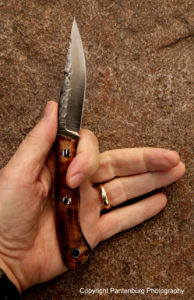
The curly maple handle is generously-sized and works well.
- Point: This knife is not a skinner, so it doesn’t need much belly in the blade. This point is used for thrusting, as in gutting and drawing a game bird. The slender point is also what you need for gutting a fish and possibly filleting it. This point is a good choice.
- Grind: The blade is flat ground with a micro bevel. This makes the knife a good slicer.
- Finish: This knife looks like it just came out of an old time blacksmith’s forge. It matches my black powder rifles really well, and that alone was enough to make me want one.
- Weight: At 3.4 ounces, the Bird and Trout weighs about as much as three shotgun shells, depending on the gauge, and the amount of shot. Point being, this is a knife you can put in your hunting vest and forget about until you need it.
- Sheath: A sturdy sheath is paramount for a rigid blade knife. You must have a way to carry the knife safely, or it is dangerous. The sheath that comes with the knife is excellent – it’s sturdy and looks really nice. When worn on the belt, the handle is about halfway exposed, making it easy to grab and replace.
- Made in USA: Lon Humphrey knives are made in Ohio. The company pays local, state and federal taxes and supports the local community. If you have a problem with one of his knives, you can get on the phone and talk to Lon in person. Buy American!
FYI: Doesn’t (really) work for me, but might for you: All knife reviews are subjective, so it goes without saying: Take any comments with a grain of salt. (My wife and I can’t even agree on what makes a good knife!) What works for my big hands may not be comfortable for a smaller person. Or vice versa. But you read this far to help with your buying decision. So here are some nit-picky observations.
Blade too thick: A bird and trout knife should have a thin blade. It is not a survival knife, and the blade doesn’t need much lateral strength. It is not designed to be a big game hunting knife. A fishing knife blade needs to be thin, so it can do a passable job filleting fish. The blade also needs to be thin enough to eviscerate a game bird.
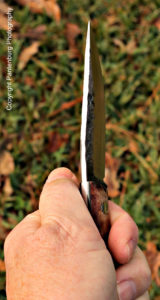
The blade would be more efficient if it were thinner.
The Bird and Trout is far more likely to be used as a paring knife in the kitchen than anything else. But the blade thickness reduces its effectiveness.
There is a potential for rust: High carbon steel rusts. You know that going it, and it’s not a deal breaker for me. I have used carbon steel blades for decades in the hot, humid swamps of the Deep South with no problem. But I also wipe the blade down immediately after using it, and put a thin coat of mineral oil on the blade before storing it.
If you don’t want to worry about your blade rusting, get stainless steel. (CORRECTION: Thanks, Jacob Allen, for pointing this out: “While Lon uses mostly carbon steels, the B&T is stainless 440C, so rust won’t be as big of a concern on this particular model.”)
Handle too narrow: (See “…wife and I can’t agree.. “^^^) Some handles that I really like are too bulky for my wife’s much smaller hands. I find the handle to be a good length, but a trifle slim for my hands. If you absolutely must have a thicker handle, a solution might be to wrap the handle with hockey stick or tennis racket wrap to bulk up the grip.
Finish: I love the hammer and forge marks on the blade – it give the knife that old-timey look I find very appealing. In fact, that finish is one reason I got a Sterling as soon as they came on the market. But if you are looking for a smooth slicer for the kitchen, you’ll need to keep looking. The combination of thick blade and rough finish means the blade will not glide through food preparation as well as some.
Grind: I like convex grinds, but that is another subjective decision. The flat grind with micro bevel works well for its intended purpose.
All in all, this knife is a solid user, that will give decades of good service in the upland game fields and on the fishing rivers. It is well-made, and a beautiful knife. You can’t go wrong with this one!

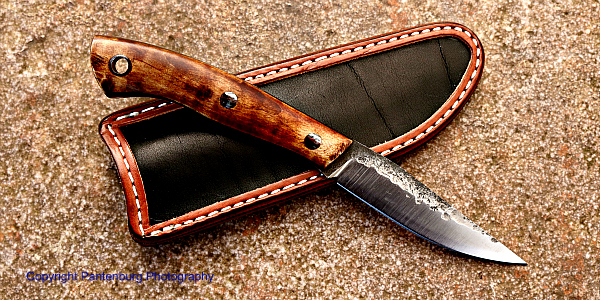
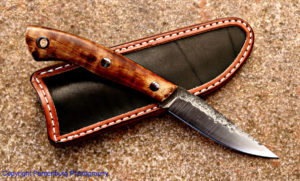
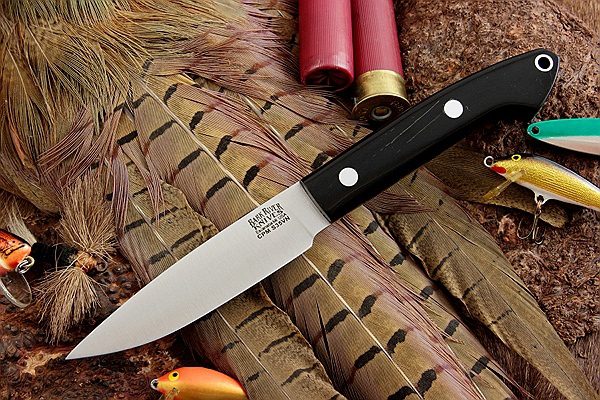
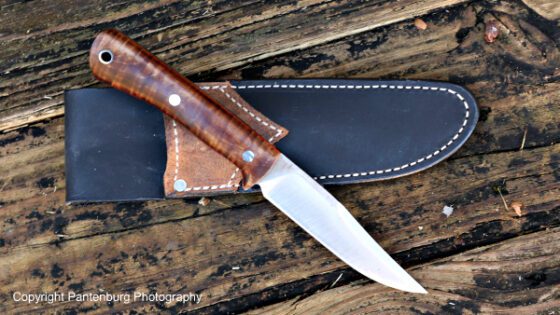
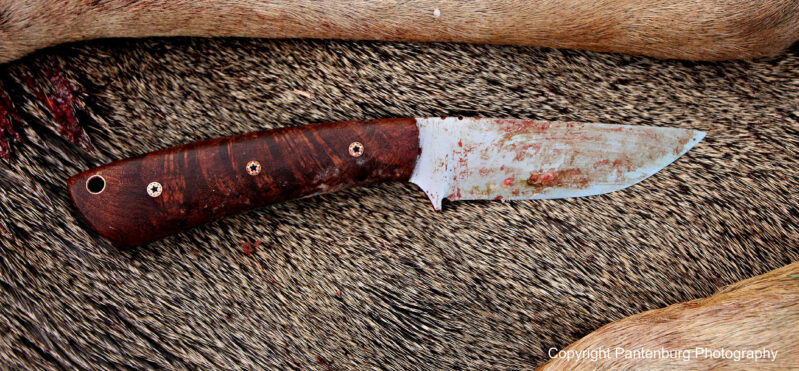
Leave a Reply